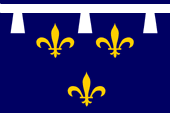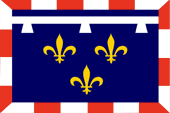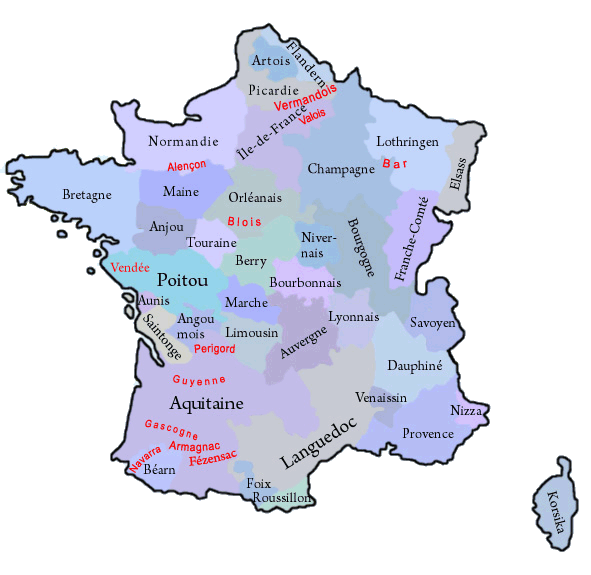mobile View, to the German Version tap the flag


- historical region in today's France
- former duchy and province
• Flag
• Meaning/Origin of the Flag
• Coat of Arms
• Meaning/Origin of the Coat of Arms
• Map of the historical Regions in France
• Explanations about the Regions
• History
• Origin of the Country's Name

Flag of Orléanais
– Drapeau de Orléanais,
Source, by: Wikipedia (D)




1960–2016,
Unofficial flag of the Centre Region
– drapeau officieux de la région Centre,
Source, by: Wikipedia (D)






The flag of Orléanais is a scutcheon flag: Its design displays the image of the coat of arms of the Dukes out of the house of Valois-Orléans. The since 1960 existing Region of "Centre-Val-de-Loire" – to which the Orléanais belongs – uses an unofficial flag, which combines features of the historical flags of Orléanais, Berry and of the Touraine.
Source:
Volker Preuß,
Wikipedia (D)


Coat of arms of Orléanais
– blason de Orléanais,
Source, by: Wikipedia (D)

When King Philipp VI. of France (from the house of the Capetians) created the Duchy of Orléans and handed it over to his younger son Philipp of Valois, became the lily-scutcheon of the Capetians supplemented with a white tournament collar, which featured Philipp – following the rules of the French heraldry – as a younger son. The coat of arms of the Capetians showed three golden lilies on blue, but originally was the coat of arms sprinkled with lilies. From 1365 (by others sources 1376), the number of lilies was reduced to three. The lily-symbol is very old, already the Germanic tribe of the Franks has used it. The House of the Capetians has provided the kings of France between 987 and 1328. It goes back to Hugo Capet, son of Hugo the Great, who was electet to the King of France, in 987, after the death of King Ludwig V. from the House of the Carolingians. The Capetians brought out three branch lines which became the Kings of France: Valois 1328–1589, Bourbon 1589–1792 and 1814–1830, and Orléans 1830–1848.
Source:
Volker Preuß,
Wikipedia (D)

The historical, French Regions:

in black: governorate and province in 1776,
in red: former county, province oder governorate
Map: Volker Preuß

The until the French Revolution existing provinces (or governorates) have been historically grown structures, which had their roots oftenly in former fiefdoms of the French crown, historic counties and duchies. They oftenly existed for hundreds of years and had preserved regionality (e.g. cultural particularities and regional languages). On the occasion of the French Revolution such phenomena were of course not desirable, and as part of their bloody and violent egalitarianism any regional references were eliminated. Shortly after the French Revolution the provinces were dissolved and France became divided into many départements, which should have approximately the same size and the same status. The départements were named after rivers or mountains, to use never and in no circumstances the name of an old province. However, there was no success in cutting the connections of the people of France to their respective regions, so that administrative regions were re-created in 1960, to have a better control in regional administrative processes. In this way became départements, which were placed in a historical province, administratively grouped to an oftenly historically named region. The resulted structures coincide only approximately with the boundaries of the old provinces. In the strictly centralist France any regionality is avoided, so that even the official flags of these regions mostly look like flags of companies, unloving, unhistorical, technocratic and modernistic, and these flags should not be a subject of any lexical considerations here. Only in a few of that regions, exist official flags which remember the historical models. But, even the existence of these today's regions is douptful, because in 2014 was passed a territorial reform valid from the year 2016, that reduces the number of the existing regions by merging to nearly the half. However, there exist unofficial flags in nearly all of these regions, which should remember the old provinces and the old heraldry.
Wikipedia Link to the regions of France:
click or tap here
FOTW Link to the regions of France:
click or tap here
Source: Flags of the World,
Wikipedia (D),
Volker Preuß

1152 · creation of the Duchy of Orléans by King Philip VI. of France by separating of the Orléanais from the royal domain and handing over to his younger son Philip of Valois
1375 · Philip dies without male descendants
1392 · re-creation of the Duchy of Orléans by King Charles VI. of France by separating of the Orléanais from the royal domain and handing over to his younger brother Louis of Valois, founder of the House of Valois-Orléans, Louis legitime son John founds the line of the Counts of Angoulême (with Francis I. as King of France), Louis illegitimate son John founds the line of the Dukes of Longueville (Orléans-Longueville)
1394 · Louis of Orléans inherits duchy and title to his son Charles
1462 · Charles of Orléans inherits duchy and title to his son Ludwig
1498 · Louis of Orléans becomes as Louis XII. King of France, the duchy comes back to the crown, the title expires
1626 · re-creation of the Duchy of Orléans by King Louis XIII. of France, by separating of the Orléanais from the royal domain and handing over to his younger brother, Jean-Baptiste Gaston
1660 · Jean -Baptiste Gaston dies without male descendants
1661 · re-creation of the Duchy of Orléans by King Louis XIV. of France, by separating of the Orléanais from the royal domain and handing over to his younger brother Philip, founder of the House of Bourbon-Orléans
1701 · Charles of Orléans inherits duchy and title to his son Philip II. of Orléans (1715-1723 Regent of France), from this line follow the Dukes Ludwig (1723-1725), Louis- Philippe (1725-1787), Louis-Philippe-Joseph (1787-1773), Louis-Philippe (1773-1850, King of France 1830-1848)
1776 · the already in the 14th century created governorates of the civil administration of the kingdom of France become committed to a number of 39, and correspond in this way to the number of provinces, in previous years could any provinces be summarized in one governorate
1789 · French Revolution, the governorates (provinces) become abolished, the Orléanais is divided into departments (Loiret, Loir-et-Cher, and partly also Eure-et-Loir and Yonne)
1960 · reintroduction of regions in France, the Orléanais doesn't play a role, affiliation with the newly created Centre-Val-de-Loire region (capital: Orléans), even not within the historic boundaries, just by integrating of the departments of Cher, Eure-et-Loir, Indre, Indre-et-Loire, Loir-et-Cher und Loiret
Source:
1.) Wikipedia (D),
2.) Wikipedia (D),
Meyers Konversationslexikon

The name "Orléanais" has its roots in Orléans, the capital of the duchy.
Source:
Volker Preuß


![]()







